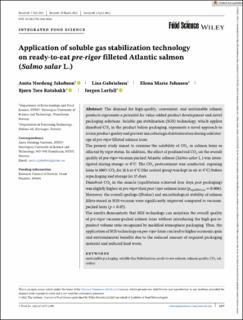Application of soluble gas stabilization technology on ready-to-eat pre-rigor filleted Atlantic salmon (Salmo salar L.)
Jakobsen, Anita Nordeng; Gabrielsen, Lisa; Johnsen, Elena Marie; Rotabakk, Bjørn Tore; Lerfall, Jørgen
Peer reviewed, Journal article
Published version
Permanent lenke
https://hdl.handle.net/11250/3046122Utgivelsesdato
2022Metadata
Vis full innførselSamlinger
- Artikler / Articles [1429]
- Publikasjoner fra CRIStin [2493]
Sammendrag
The demand for high-quality, convenient, and sustainable salmon products represents a potential for value-added product development and novel packaging solutions. Soluble gas stabilization (SGS) technology, which applies dissolved CO2 in the product before packaging, represents a novel approach to retain product quality and prevent microbiological deterioration during cold storage of pre-rigor filleted salmon loins. The present study aimed to examine the solubility of CO2 in salmon loins as affected by rigor status. In addition, the effect of predissolved CO2 on the overall quality of pre-rigor vacuum-packed Atlantic salmon (Salmo salar L.) was investigated during storage at 4°C. The CO2 pretreatment was conducted, exposing loins to 100% CO2 for 18 h at 4°C (the control group was kept in air at 4°C) before repackaging and storage for 15 days. Dissolved CO2 in the muscle (equilibrium achieved four days post packaging) was slightly higher in pre-rigor than post-rigor salmon loins (pequilibrium = 0.006). Moreover, the overall spoilage (Hvalue) and microbiological stability of salmon fillets stored in SGS-vacuum were significantly improved compared to vacuum-packed loins (p < 0.05). The results demonstrate that SGS technology can maintain the overall quality of pre-rigor vacuum-packed salmon loins without introducing the high gas-to-product volume ratio recognized by modified atmosphere packaging. Thus, the application of SGS technology on pre-rigor loins can lead to higher economic gain and environmental benefits due to the reduced amount of required packaging material and reduced food waste.
